07579
Synperonic® F 108
surfactant, non-ionic
Synonym(s):
Poly(ethylene glycol)-block-poly(propylene glycol)-block-poly(ethylene glycol), Poly(propylene glycol)-block-poly(ethylene glycol)-block-poly(propylene glycol)
Sign Into View Organizational & Contract Pricing
All Photos(1)
About This Item
CAS Number:
MDL number:
UNSPSC Code:
12352112
PubChem Substance ID:
NACRES:
NA.22
Recommended Products
Quality Level
impurities
≤0.5% water
mp
56-61 °C
hydroxyl value
6‑9 mg KOH/g
application(s)
detection
InChI
1S/C3H6O.C2H4O/c1-3-2-4-3;1-2-3-1/h3H,2H2,1H3;1-2H2
InChI key
RVGRUAULSDPKGF-UHFFFAOYSA-N
Looking for similar products? Visit Product Comparison Guide
General description
Synperonic F-108 is a polyoxyethylene-polyoxypropylene block copolymer. It has two hydrophilic groups that are attached to a central hydrophobic group that self-assembles in an aqueous solution into clusters known as micelles. This water-soluble surfactant is used as effective emulsification and solubilizing agent in a wide range of applications.
Application
Synperonic® F 108 may be used as an adjuvant for lentiviral (LV) transduction. It possesses higher (LV) transduction efficiency than polybrene.
Legal Information
Synperonic is a registered trademark of Croda International PLC
Storage Class Code
10 - Combustible liquids
WGK
WGK 1
Flash Point(F)
Not applicable
Flash Point(C)
Not applicable
Personal Protective Equipment
dust mask type N95 (US), Eyeshields, Gloves
Choose from one of the most recent versions:
Already Own This Product?
Find documentation for the products that you have recently purchased in the Document Library.
Customers Also Viewed
Feby Wijaya Pratiwi et al.
Biomedicines, 9(1) (2020-12-31)
Mesoporous silica nanoparticles (MSNs) have emerged as a prominent nanomedicine platform, especially for tumor-related nanocarrier systems. However, there is increasing concern about the ability of nanoparticles (NPs) to penetrate solid tumors, resulting in compromised antitumor efficacy. Because the physicochemical properties
Ines Höfig et al.
The journal of gene medicine, 14(8), 549-560 (2012-08-14)
Although lentiviral transduction methods are widely used, their broader application is dependent upon the optimization of lentiviral transduction efficiency for a broad range of cell types. In the present study, we focus on the evaluation of two chemical classes with
Bishnubrata Patra et al.
Scientific reports, 6, 21061-21061 (2016-02-16)
Three-dimensional (3D) tumor spheroid possesses great potential as an in vitro model to improve predictive capacity for pre-clinical drug testing. In this paper, we combine advantages of flow cytometry and microfluidics to perform drug testing and analysis on a large
Jianan Shen et al.
Biomaterials, 34(5), 1581-1590 (2012-11-14)
The metastasis of breast cancer is the leading cause of cancer death in women, and the lung is a common location of a secondary tumor that has metastasized from the primary source tumor. In this work, an attempt to simultaneously
Tsz Chung Lai et al.
Colloids and surfaces. B, Biointerfaces, 99, 27-37 (2011-10-18)
Polyplex particles formed with plasmid DNA (pDNA) and Pluronic P85-block-poly{N-[N-(2-aminoethyl)-2-aminoethyl]aspartamide} (P85-b-P[Asp(DET)]) demonstrated highly effective transfection ability compared to PEG-based block cationomer, PEG-b-P[Asp(DET)]. Ternary polyplexes comprising PEG-b-P[Asp(DET)], poly(ethylene oxide)-b-poly(propylene oxide)-b-poly(ethylene oxide)-b-P[Asp(DET)] (P(EPE)-b-P[Asp(DET)]) used as an analog of P85-b-P[Asp(DET)], and pDNA were
Our team of scientists has experience in all areas of research including Life Science, Material Science, Chemical Synthesis, Chromatography, Analytical and many others.
Contact Technical Service



